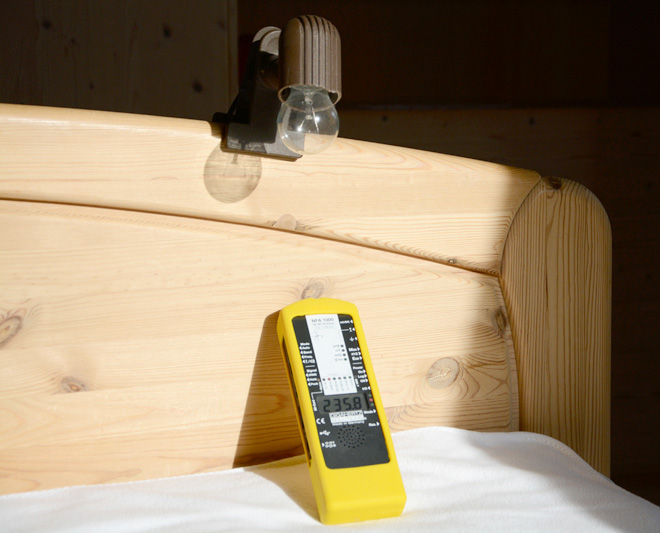
Avoiding alternating electric fields at the sleeping place
The sleep disturbances began with the new furniture
Sabine Loderer from Ansbach in Bavaria/Germany moved into a new bedroom within the house. Fittingly, the couple had purchased a new double bed in June. The selected model has a reading lamp integrated on the left and right side of the headboard. Sabine Loderer has been sensitive to electrosmog for several years and therefore had a mains decoupler installed in the circuit of the old bedroom. This device interrupts the power supply when the last “consumer” has been disconnected from the mains. In the new bedroom, this protective device was still missing. In recent weeks, Mrs. Loderer noticed that she was sleeping increasingly poorly. She wanted to get to the bottom of the cause and commissioned the building biologist Oliver Zenkel to conduct a sleeping place investigation.
Above-average electric alternating fields in the sleeping area
The building biologist did not know about the lamp before starting his work. As a matter of routine, he placed his NFA1000 measuring device in the upper third of the bed and read a value of 15 volts per meter (V/ m). Compared to the standard of building biology measurement technology (SBM 2015), the measurement result represents an extreme anomaly. When using the potential-free measurement method, only a value of less than 0.3 volts per meter is considered inconspicuous. The measurement range between 0.3 and 1.5 V/m is classified as “slightly conspicuous” according to SBM. As soon as Zenkel brought the measuring device closer to the reading lamp, the measured value rose sharply and reached a peak value of 236 volts per meter at a distance of ten centimeters. The cause was thus clearly identified. The lamp should be disconnected from the power supply during the night’s rest. The easiest way to do this is with a toggle switch and an integrated pilot lamp.
Theoretical basics about electric fields
Low-frequency alternating electric fields, as they are called in full, occur in the presence of different electric potentials or electric voltage. The electric field strength therefore corresponds to the spatial gradient of the potential. In the domestic environment, electric fields are caused by power lines installed in the building, by plugged-in electrical devices, and possibly also by power lines from outside the home. Lay people are often unaware that it is not necessary for electric current to flow for electric fields to occur. In other words, the voltage is already generated when the device with the plug is in the circuit.
The potential-free measurement prevents measurement errors
When measuring low-frequency alternating electric fields, the experience of building biologists is important, because the values can be influenced and “distorted” by conductive objects. E-field strength measurements have to be carried out with great care and expertise, because the measuring equipment itself and the measuring person can change the original field. Therefore, potential-free measurement methods, such as those using the NFA1000 or the ROM cube, reduce measurement errors to a large extent. The advantage of low-frequency fields over radio waves is that the field strength decreases sharply at a distance of at least one meter. Nevertheless, bedside lamps should be disconnected from the power supply during sleep for health precautionary reasons.
Feel free to call – we will answer your questions about electrosmog.
